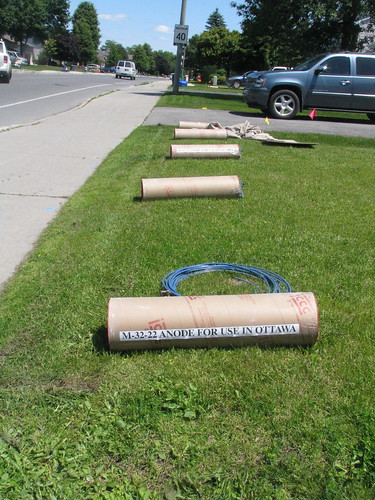Taken a week or so ago on Merkley Drive in the Fallingbrook section of Orléans. These devices have been seen around the neighbourhood in a number of front yards, and subsequently buried underground. Can anyone guess their purpose?
The one clue at present is that the City of Ottawa has sent vehicles labelled “Services – Drinking Water” to the scenes of several such burials.


2 comments
Anodes like that are used to protect older cast iron water mains from corrosion. The anode is connected to the pipe by a wire which simplifies installation (The anode doesn’t have to be buried deep). Test stations are also connected at some locations, usually under a cover in the ground or attached to a nearby pole. When a test station is present, the blue wire runs to the anode underground and two white wires run to the pipe, all connected at the test point.
New water mains are usually blue or white plastic so anodes are only required at valves and some fittings in high pressure locations.
Alex is right – they’re “sacrificial anodes”. If two different kinds of metal get submerged in water together, it starts a low voltage electrical reaction that results in the “weaker” metal corroding and breaking down. To avoid this breaking down the iron pipes, they install anodes made of an even “weaker” metal that get broken down first.
http://chemwiki.ucdavis.edu/Analytical_Chemistry/Electrochemistry/Case_Studies/Corrosion/Sacrificial_Anode